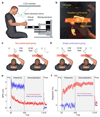Multiple motor memories are learned to control different points on a tool
- PMID: 29736420
- PMCID: PMC5935225
- DOI: 10.1038/s41562-018-0324-5
Multiple motor memories are learned to control different points on a tool
Conflict of interest statement
Competing interests The authors declare no competing interests.
Figures




Similar articles
-
Motor memories in manipulation tasks are linked to contact goals between objects.J Neurophysiol. 2020 Sep 1;124(3):994-1004. doi: 10.1152/jn.00252.2020. Epub 2020 Aug 20. J Neurophysiol. 2020. PMID: 32816611 Free PMC article.
-
Separate motor memories are formed when controlling different implicitly specified locations on a tool.J Neurophysiol. 2019 Apr 1;121(4):1342-1351. doi: 10.1152/jn.00526.2018. Epub 2019 Jan 9. J Neurophysiol. 2019. PMID: 30625003 Free PMC article.
-
Interference between competing motor memories developed through learning with different limbs.J Neurophysiol. 2018 Sep 1;120(3):1061-1073. doi: 10.1152/jn.00905.2017. Epub 2018 May 23. J Neurophysiol. 2018. PMID: 29790834 Free PMC article.
-
Reap while you sleep: Consolidation of memories differs by how they were sown.Hippocampus. 2023 Aug;33(8):922-935. doi: 10.1002/hipo.23526. Epub 2023 Mar 27. Hippocampus. 2023. PMID: 36973868 Free PMC article. Review.
-
Motor Learning and the Cerebellum.Cold Spring Harb Perspect Biol. 2015 Sep 1;7(9):a021683. doi: 10.1101/cshperspect.a021683. Cold Spring Harb Perspect Biol. 2015. PMID: 26330521 Free PMC article. Review.
Cited by
-
Implicit Adaptation Is Modulated by the Relevance of Feedback.J Cogn Neurosci. 2024 Jun 1;36(6):1206-1220. doi: 10.1162/jocn_a_02160. J Cogn Neurosci. 2024. PMID: 38579248 Free PMC article.
-
Better grip force control by attending to the controlled object: Evidence for direct force estimation from visual motion.Sci Rep. 2019 Sep 11;9(1):13114. doi: 10.1038/s41598-019-49359-8. Sci Rep. 2019. PMID: 31511634 Free PMC article.
-
Motor memories of object dynamics are categorically organized.Elife. 2021 Nov 19;10:e71627. doi: 10.7554/eLife.71627. Elife. 2021. PMID: 34796873 Free PMC article.
-
Sensorimotor Challenges in Minimally Invasive Surgery: A Theoretically-Oriented Review.Hum Factors. 2025 Feb;67(2):141-165. doi: 10.1177/00187208241263684. Epub 2024 Jul 22. Hum Factors. 2025. PMID: 39038166 Free PMC article. Review.
-
Different mechanisms of contextual inference govern associatively learned and sensory-evoked postural responses.Proc Natl Acad Sci U S A. 2024 Aug 6;121(32):e2404909121. doi: 10.1073/pnas.2404909121. Epub 2024 Aug 2. Proc Natl Acad Sci U S A. 2024. PMID: 39093946 Free PMC article.
References
-
- Shadmehr R, Smith MA, Krakauer JW. Error correction, sensory prediction, and adaptation in motor control. Annu Rev Neurosci. 2010;33:89–108. - PubMed
-
- Wolpert DM, Diedrichsen J, Flanagan JR. Principles of sensorimotor learning. Nat Rev Neurosci. 2011;12:739–751. - PubMed
-
- Johansson RS, Westling G. Roles of glabrous skin receptors and sensorimotor memory in automatic control of precision grip when lifting rougher or more slippery objects. Exp Brain Res. 1984;56:550–564. - PubMed
-
- Johansson RS, Flanagan JR. Coding and use of tactile signals from the fingertips in object manipulation tasks. Nat Rev Neurosci. 2009;10:345–359. - PubMed
-
- Ingram JN, Wolpert DM. Naturalistic approaches to sensorimotor control. Prog Brain Res. 2011;191:3–29. - PubMed
Grants and funding
LinkOut - more resources
Full Text Sources
Other Literature Sources

